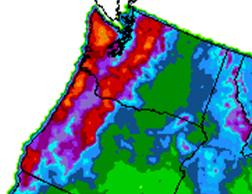
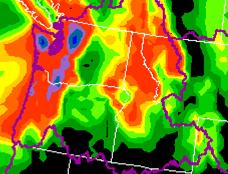
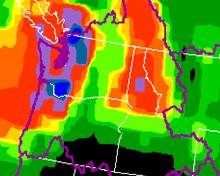
|
Knowing that the SREF predicted moisture flux anomalies are suggesting that a rare heavy event might be in the offing, how might the forecaster modify the model forecasts below? |
|
One possible method would be to employ the Hamill and Whitaker (2006) reforecast analog products that employ a low resolution version of the GFS for its individual members and then uses the resultant ensemble mean QPF and PW fields to identify analogs that can be used to construct an ensemble suite. Such a method then can be calibrated to produce bias adjusted probabilities for various precipitation thresholds. The method also can be used to provide a guidance product that tells the forecaster the precipitation amount that was only exceeded in 10 percent of the cases identified by the reforecast analog technique for that particular day. The graphic below left is such a product for the 24 hrs ending at 1200 UTC 7 Nov. 2006. |
|
12-36 hr QPF from the GFS model. |
|
24-h analog ensemble QPF-90th percentile (upper decile) (in) product valid 1200 UTC 7 Nov. 2006. |
|
24-h accumulated precipitation (4 km grid) valid 1200 UTC 7 Nov. 2006. |
|
Compare the analog forecast amounts to those predicted by GFS and NAM in the area enclosed by the circle and compare those amounts the high resolution precipitation analysis for the same time period (below left). Essentially, the analog method had the best forecast in the area enclosed by the circle. Note that the analog predicted over 8 inches in the Olympic mountains where over 10 was reported but where the GFS only predicted 3. Also, it did better than either the GFS or NAM in the mountains along the coast of northwest Oregon. During this period, Lee’s Camp in Oregon received 14.3 inches and June Lake in Washington received over 15. Record flooding was reported on 10 rivers and 16 counties were declared to be in a state of emergency by the governor or Washington. The standardized anomalies correctly identified a rare event. |

|
Where analog method fails is that it spreads the heavy rainfall too far south in Oregon. Also note that in areas outside the circle the analog technique tended to forecast too much rainfall. The method tends to predict too large an area of heavy rainfall because of the way it identifies heavy cases. It also tends to forecast too much precipitation to the lee of the Cascade range where the rain shadow is typically located. For the areal extent of the more moderate amounts, a position near the middle of the two higher resolution models usually will be better than the analog. The way the analog method downscales the precipitation using mountain mapper also tends to cause it to overpredict precipitation in the mountains in regions away from the axis of stronger moisture flux and orographic lifting. The NAM and GFS will usually provide a better idea of the general coverage of the precipitation than the analog product but the latter will often offer a better guess at the maximum rainfall when the moisture flux and PW are highly anomalous. |
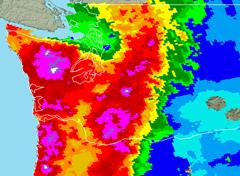
|
The greater than 3 SD and 5 SD departure from normal for PW and 850-hPa moisture flux predicted by the SREF ensemble mean suggests that this event will at least equal the 24-h QPF from upper 10% of the reforecast project analogs (left). Therefore, in the area where the strongest moisture flux is aimed the longest (roughly the area inside the circle), the precipitation amounts should be similar if not a little higher than suggested the reforecast analog product. |
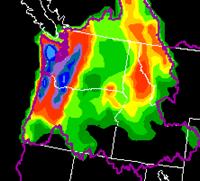
|
24-h accumulated precipitation (32 km grid) valid 1200 UTC 7 Nov. 2006. |
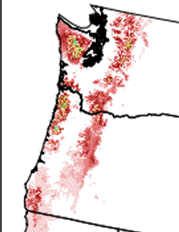
|
Another tool providing by the analog ensembles is a calibrated probability for various precipitation thresholds (a PQPF). This tool is available through day 10 on the HPC workstations in NMAP. The example at right provides the calibrated PQF for 4.00 inches during the 24-hr period ending at 1200 UTC 7 November 2006. The fact that the calibrated PQPF product was forecasting areas with greater than a 60% probability is telling since 4.00” events are a relatively rare occurrence. |
|
For shorter range forecasts east of the mountains of the west, the analog products like the ensemble mean usually are not as reliable as the higher resolution model QPFs at the shorter time ranges. |
|
12-36 hr QPF from the NAM model, scale in inches at left. |